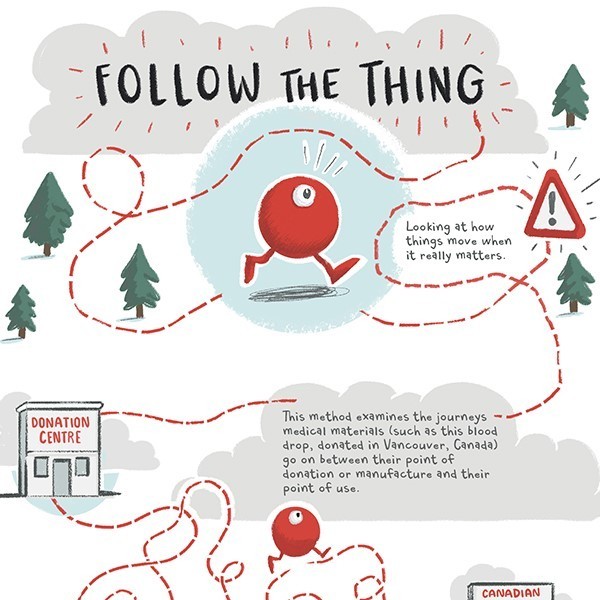Creative collaboration visualises complex journey of blood from donation to transfusion
A research method used by Dr Stephanie Sodero, HCRI Lecturer in Responses to Climate Crises, is now available as a scrollable illustration, visualising her work on the formidable and often invisible journeys of medical supply chains.
 Methods for Change is a project funded by Aspect and Research England that shares creative research methods used in the social sciences with the broader community, including government and NGOs, to support innovative research and enact positive social change. Some of the highlighted research methods include 'follow the thing,’ photo go-alongs, and participatory mapping.
Methods for Change is a project funded by Aspect and Research England that shares creative research methods used in the social sciences with the broader community, including government and NGOs, to support innovative research and enact positive social change. Some of the highlighted research methods include 'follow the thing,’ photo go-alongs, and participatory mapping.
Dr Stephanie Sodero describes her initial vision for the project: "The main character is a drop of donated blood. The reader follows the blood drop journey, from testing to processing through to a car crash and the point of transfusion. I knew I wanted to focus on the blood drop, and the illustrator brought the story to life."
View the scrollable illustration.
Illustrator, Jack Brougham, designed the scroll to depict the journey of a single drop of blood to showcase how Dr Sodero used the ‘follow the thing' method.
Based on Dr Sodero's publication 'Vital mobilities: circulating blood via fictionalised vignettes', the fictional journey uses creative storytelling to outline the complex mobilities involved in the blood supply chain, from the point of donation to the point of care. Further, as shown in the illustration, Dr Sodero highlights connections to climate change. Namely that the blood donor system relies on fossil-fuelled transport, like trucks and planes, that contribute to climate change, and in turn, severe weather events disrupt the medical supply chains upon which society relies.
As part of the Methods for Change project, the scroll can be accessed via an online platform that showcases the value of social sciences methods to researchers outside of academia. In today's interconnected world, where global supply chains both contribute to and are impacted by climate change, 'follow the thing' is a valuable research tool. It can be applied to a range of goods, from tea to smartphones, exposing unjust working conditions and environmental harms, encouraging more ethical consumer and corporate behaviour.
Dr Sodero adds: "By following the drop of blood, you get a sense of just how complex the blood donation journey is in terms of time, space, and pace, and given this, how such a journey is vulnerable to disruption from severe weather events like flooding and snowstorms. For example, in 2012, the largest blood processing facility in Europe (located near Bristol) flooded, resulting in a two-week closure."
"My research centres on how medical supply chains – blood, saline, oxygen – are impacted by a changing climate. I co-lead a Mobile Medical Materials working group where we discuss a range of goods, from abortion pills to PrEP, used to prevent HIV transmission. In terms of creative methods, we maintain a gallery of outside-the-box projects that explore mobile medical materials."
The 'follow the thing' method is useful for organisations, such as businesses, charities, activist organisations, government departments interested in thinking through unseen dynamics in provisioning, the environmental impacts of everyday products, and how these processes link to social and material inequalities. It may be used in research that proves vital for disaster management, fair trade, waste management, and more. An accessible guide on how to use the method in more detail is also available.
To learn more about the Methods for Change project, visit their website.
To learn more about Dr Stephanie Sodero's research, visit her website.

